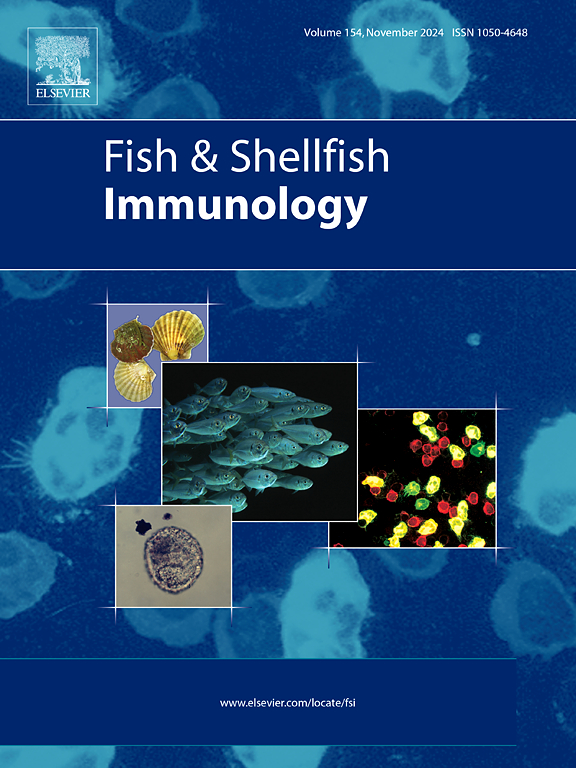Edwardsiella piscicida effector EseD mediates ferritinophagy by targeting NCOA4 and STING in teleost cells
IF 3.9
2区 农林科学
Q1 FISHERIES
引用次数: 0
Abstract
Edwardsiella piscicida (E. piscicida), an important pathogen in aquatic systems, has been demonstrated to hijack Ncoa4 (nuclear receptor co-activator 4)-dependent ferritinophagy through its type III secretion system effector EseD, thereby promoting intracellular bacterial survival. However, the molecular mechanisms governing EseD-mediated ferritinophagy remain elusive. To address this issue, the lysosomal localization analysis was performed to observe that EseD promoted the Ncoa4 translocation to lysosomes, corroborating the involvement of EseD in ferritinophagy-mediated target protein degradation. Subsequently, by employing co-immunoprecipitation and confocal microscopy, this study revealed that EseD specifically interacted with both Ncoa4 and ferritin, as well as orchestrated the formation of Ncoa4-ferritin complex. These findings provided direct evidence for EseD-induced ferritinophagic flux. Furthermore, it was the first time to characterize the function of stimulator of interferon gene (Sting) as an integral component of the ferritinophagy complex in fish, in which Sting was detected to co-localize with the Ncoa4, ferritin and EseD, suggesting that Sting participated in EseD-induced ferritinophagic complex assembly. Collectively, these data establish a novel pathogenic mechanism where E. piscicida exploits EseD-mediated Ncoa4-ferritin-Sting complex to manipulate host ferritinophagy for intracellular persistence. This work advances our understanding of host-pathogen interactions at the intersection of ferritinophagy, providing new therapeutic targets for controlling E. piscicida infection in aquaculture.
Edwardsiella piscicida效应物EseD通过靶向硬骨鱼细胞中的NCOA4和STING介导铁蛋白自噬
piscicida Edwardsiella (E. piscicida)是水生系统中的重要病原体,已被证明通过其III型分泌系统效应物EseD劫持Ncoa4(核受体共激活物4)依赖的铁蛋白自噬,从而促进细胞内细菌的存活。然而,控制esed介导的铁蛋白自噬的分子机制仍然难以捉摸。为了解决这一问题,我们进行了溶酶体定位分析,观察到EseD促进了Ncoa4向溶酶体的易位,证实了EseD参与了铁蛋白吞噬介导的靶蛋白降解。随后,通过共免疫沉淀和共聚焦显微镜,本研究揭示了EseD与Ncoa4和铁蛋白特异性相互作用,并精心策划了Ncoa4-铁蛋白复合物的形成。这些发现为esed诱导铁蛋白自噬通量提供了直接证据。此外,该研究首次表征了干扰素刺激因子(Sting)作为鱼体内铁蛋白自噬复合物的组成部分的功能,并在其中检测到Sting与Ncoa4、铁蛋白和EseD共定位,提示Sting参与了EseD诱导的铁蛋白自噬复合物组装。总的来说,这些数据建立了一种新的致病机制,其中piscicida利用esed介导的ncoa4 -铁蛋白- sting复合物来操纵宿主的铁蛋白自噬以实现细胞内持久性。本研究促进了我们对嗜铁蛋白交叉作用下宿主-病原体相互作用的理解,为控制水产养殖中淡鱼绦虫感染提供了新的治疗靶点。
本文章由计算机程序翻译,如有差异,请以英文原文为准。
求助全文
约1分钟内获得全文
求助全文
来源期刊

Fish & shellfish immunology
农林科学-海洋与淡水生物学
CiteScore
7.50
自引率
19.10%
发文量
750
审稿时长
68 days
期刊介绍:
Fish and Shellfish Immunology rapidly publishes high-quality, peer-refereed contributions in the expanding fields of fish and shellfish immunology. It presents studies on the basic mechanisms of both the specific and non-specific defense systems, the cells, tissues, and humoral factors involved, their dependence on environmental and intrinsic factors, response to pathogens, response to vaccination, and applied studies on the development of specific vaccines for use in the aquaculture industry.
 求助内容:
求助内容: 应助结果提醒方式:
应助结果提醒方式:


